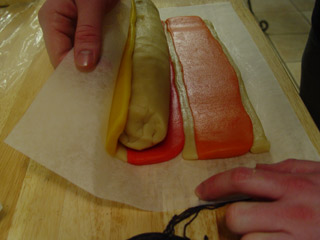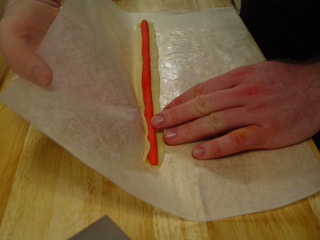SugarCookies
...just in case Joseph Hall's blog goes down:
Ubuntu Logo Sugar Cookies
Sugar cookies are an interesting thing. The dough is what's known as a short dough. I'd always wondered what was meant by "short dough" until I learned where shortening comes from. It's a classic battle of fat and water. For the unindoctrinated, wheat flour contains two proteins: gliadin and glutenin. When these two proteins get together and get wet, they turn into gluten. And the more gluten is worked (via mixing, kneading, etc), the more elastic it gets, which of course makes it chewier. This is definitely a good thing for bread, especially my favorite, sourdough bread. This is also a very bad thing for something like cake. The more protein a flour has, the more gluten can be formed with it, and the longer those gluten strands can be. This is why bread flour has a lot of protein (usually somewhere around 12-13%), and cake flour has very little (somewhere around 7-8%). In the middle, we have all-purpose flour, which is closer to 10-11%.
The interesting thing is, gluten has a hard time developing in the presence of fat. The fat actually shortens the gluten strands. This is where vegetable shortening gets its name: it's frequently used in short doughs. In truth, butter, margarine and any other fat can do the same thing. And might I note, butter tastes a lot better than shortening. Because sugar cookie dough is so short, it can actually be worked like playdough. It can also be colored like playdough. And unlike playdough, it can even be flavored. And so without further ado, I present the ingredients:
- 1 1/2 cups unsalted butter, softened
- 2 cups granulated sugar
- 2 eggs
- 2 teaspoons vanilla
- 2 cups all-purpose flour
- 1 teaspoon baking powder
*Note* Recipe may need to be adjusted. Dough is very moist, and there is a lot of spread when the cookies are baked, even from frozen. Additionally, cook time should be reduced to 5-8 minutes, or until cookies begin to brown on the edges.
If you remember the creaming method from our chocolate chip cookies, then you know how to put this together: cream together the butter and sugar, slowly add the eggs and vanilla, and then whisk together the flour and baking powder before adding it as well. When it all comes together, wrap it in plastic wrap and toss it in the fridge for a couple of hours. I wondered once if chilling the dough really mattered. After my first attempt to work it before chilling it, I decided that it did matter, so don't skip this step. You can knead it later to make it pliable again.
You may notice that this is not a very wet dough. In fact, it's a good deal drier than the chocolate chip cookie dough. That's okay, because chocolate chip cookies only get to be scooped. These cookies get to be formed. In fact, they get to be rolled and formed into logs, chilled again, and then sliced into cookies. In fact, this form of sugar cookie is called a "refrigerator cookie" or "icebox cookie" for this very reason.
I have seen a couple different classic patterns with this type of dough. Both involve cutting the dough in half and giving each half a different color and flavor. Then you can roll each color out seperately into long little rectangles, lay one color on top of the other, and then roll those together lengthwise so that they form spirals when cut. Or you can form each color into a square log, cut lengthwise into smaller square logs, and then put those all together in a checkerboard pattern. Both are very popular designs. But who am I to conform?
It doesn't really surprise me that the best Linux distribution also has the logo that translates into the best sugar cookie. Let's face it: Ubuntu is one sweet distro. I apologize now to Canonical Ltd. for unauthorized use of their logo. Let's hope that in the spirit of Ubuntu, they will be as awesome in their forgiveness as they are in their flavor of Linux.
There are a couple of things to remember when forming a design with a log of sugar cookie dough. You will be breaking your design into shapes that can be extruded into long logs, assembled, and then cut. Because of this, simplicity is key. Ubuntu Linux has a relatively simple logo, which as an added bonus, is round. This means that Ubuntu cookies are actually a pretty good place to start when practicing more complex designs.

You need four different colors of dough. About 2/3 to 3/4 of the dough will need to be plain. The rest of it will need to be divided into three equal portions. One portion will need to be yellow, one orange and one red. And if your red comes out pink, don't worry. Using food coloring to get something completely red is nearly impossible. Just do your best.
About 1/4 of each color will be used as the head. Go ahead and divide that out. Roll that small portion out into regular round little logs. Then move those logs to a sheet pan, and move that sheet pan to the freezer. Trust me, this will make things easier later. The rest of the dough needs to be rolled out into long rectangular logs of exactly the same size. You will also want to roll out some plain cookie dough into a long rectangular log the same thickness as the colored ones, but not so wide. Cut the plain dough lengthwise into thirds, and then assemble all your logs together, with a strip of plain dough between each color. By the way, you'll probably want to assemble all of this on a piece of parchment paper.

Take some more plain cookie dough and roll it into a nice, thick log. Then move that log on top of the colored pieces, and wrap them around it. If you had them set up on parchment, you can use the parchment to lift the dough up instead of having to use your fingers.

If you have a U-shaped terrine mold like mine, you can park your dough in there for the moment. This will help keep the dough nice and round. Since you probably don't have a terrine mold, you could probably cut a PVC pipe in half and use that. Since that is probably also a little too intensive for cookies, there is another solution to keep it round. After you put your dough in the fridge, just pull it out every few minutes or so and give it a quick roll, until it's cold enough to hold its shape. Or just let it sit and hope it doesn't get too lopsided. You might not want to chill it just yet, though.
Go ahead and roll out a thin sheet of plain cookie dough. Again, this will be easier in a moment if you do it on parchment. Take one of your really small, round logs out of the freezer and put it on the plain dough. Roll a thin layer of plain dough around it and set it aside. See how much easier that is with frozen dough? Go ahead and do all three, put them back in the freezer, and then take a breath because it's about to get a little tricky.

As you can see from the logo above, there is a little indentation on each color, where the head sits. Use the handle of a spatula, spoon, anything just about the side of your three little logs, to press a little space into each color of your big log. Go ahead and set that aside for now. Roll out a good bit of plain cookie dough. It'll be good to have that ready. Pull one of your little heads out of the freezer, and place it into one of the little spaces on the big log. Since the little log is frozen, and by this point the big log is pretty pliable, you should be able to mash it in there a little and get a nice, tight fit. Remember: yellow arms have an orange head, red arms have a yellow head, and orange arms have a red head.

With all of the heads in place, go ahead and put the whole thing on top of your rolled out plain cookie dough and roll it all up. Make sure to apply a little pressure so that the dough all mashes into itself, so that there's no air holes left. When you look at it from the side, it will kind of, sort of look like an Ubuntu logo. Don't worry, it will look better when it's cut.

This completed log can be refrigerated for a few days, or frozen for up to a month. If you decide to freeze it, make sure it has a few hours to thaw in the fridge before you try to cut it. When you do cut it, you want your slices to be just shy of 1/4-inch thick. Lay them out on a piece of parchment so that the sides aren't touching. They won't spread very much, but they will spread a little. Bake them at 375F for about 10 to 12 minutes, until the edges just barely start to brown. Pull them and let them cool for a minute or two before moving the sheet of parchment from the cookie sheet to a cooling rack. Fresh from the oven, these cookies will be soft and just a little chewy. Fully cooled, they will be nice and crispy.

Remember, simplicity is key. Tomorrow I will post the Tux penguin cookies that I attempted to make before I did the Ubuntu logo. In retrospect, it wasn't bad for a first try. Then again, maybe I shouldn't have tried it in the first place. For those who will be in the Orem, UT area tomorrow evening and want to sample these cookies, I will bring some with me to this month's PLUG meeting.
originally posted by Joseph Hall on http://blog.josephhall.com/2006/11/sugar-cookies.html at 11/07/2006 10:00:00 AM
SugarCookies (last edited 2010-05-26 04:18:01 by c-24-62-239-208)